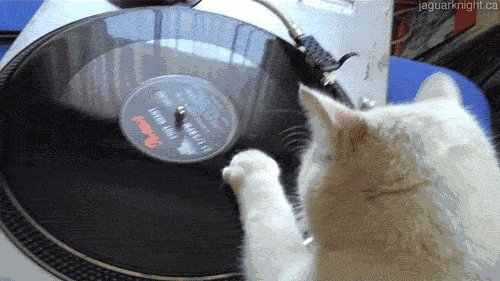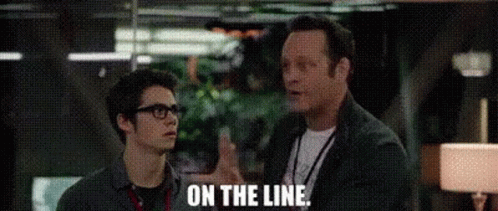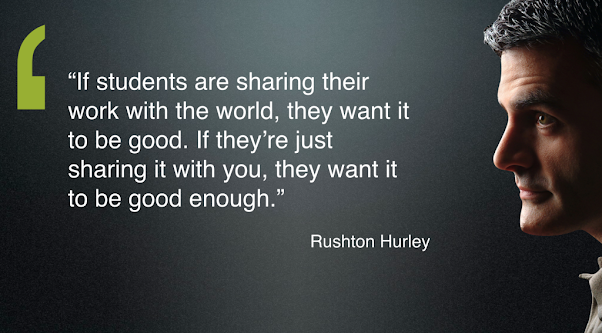This is the last in the “Rethinking Grading and Assessment Practices” series, and I have thoroughly enjoyed writing these thoughts down, and hopefully, they are helping school communities on this journey. Thanks to Katie Novak for the push to share some of my thinking and stories on these practices!
In Part 1 of “Rethinking Grading and Assessment Practices,” I shared my thoughts on the question, “Why do we need to rethink how we assess and grade in schools today?”
In Part 2, I discussed how essential it is to lead this initiative with your community. If you try to do this “for” your community without their input, you might spend more time arguing than moving forward.
As I wrote this series, there was a thinking behind the order of these posts, so I encourage you to check out the earlier posts in order if you haven’t read them already.
In today’s post, I wanted to share some ideas on creating a (digital) portfolio as an alternative, or at least as a complement, to the traditional report card. I write the word “digital” in brackets above as I am not sure it makes sense in a world where technology is ubiquitous. For example, if I Google something I don’t know, am I “blending” my learning, or am I just learning? Just something to consider.
If you are interested in exploring more about portfolios after this post, I encourage you to go to this page as I have been exploring this topic and its benefit for learning for over a decade. In fact, you might be reading this post on my blog, which I established as my own portfolio when I first started to explore this topic from the viewpoint of a learner.
What doors can open through the use of an online portfolio?
Years ago, I remember having a conversation with a teacher who told me about a student in his grade 11 (junior year) literacy course and an incredible story that I still share to this day. He encouraged students to create an “About.Me” page, which is similar to an “Internet cover letter.” He asked them to share who they are, what they wanted to do, and to list all of their social networks on the page as well.
(Insert record scratch noise here!)

Consider the following question; do you even believe that 50% of the students graduating from your school district could list all of their social networks to an employer or college and benefit? Would most of them lose opportunities, or would they benefit from their online presence? Not because they are doing anything truly horrible, but because they are doing similar things to what you and I did when we were in high school, just now online.

Consider that last sentence.
I always challenge people with the following statement; if your worst ten minutes were online, would you currently have a job? I haven’t met many people (including myself) that could honestly say “Yes!” In fact, many people will start sorting between which ten minutes in their life was worse.
As humans, we are deeply flawed, and all have made mistakes. We need to have more empathy for others with that dose of truth, but that is for another post.
But back to the story of this teacher.
Knowing that people outside were googling potential employees or those who applied for college admissions, he decided to help students use that to their advantage. If someone was looking doing an Internet search on you to ensure that you were not doing anything “bad” what happens when they find that you are doing incredible things instead? It would put anyone sharing those positives into a place of advantage.
In fact, one of his students applied to her dream school and didn’t get in because of her grades. What did she do? She contacted the school and asked them to “Google” her and see what they find. They did. Shortly after that search, they accepted her to that college. It was an incredible story and is happening more often.
What does this have to do with report cards and grades?
If you remember in the first post of this series, I discussed how people were becoming more interested in what people were doing online than traditional report cards because it allows you to go deeper into the strengths and abilities of a person.
So consider these two scenarios; if a college or employer is looking at both what you are doing online and a report card, would a student be more likely to overcome bad grades with an amazing footprint online, or a terrible digital footprint, with great grades?
Which one has more potential to tell the varied stories of students as they leave their K-12 school experience??
Going beyond the “product” and sharing the “process.”
One of the things that really frustrates me in education is when it is said that “We need to get rid of standardized testing!” Not that I don’t agree with the statement, but often what is missing is providing an alternative solution. That is why I started looking into portfolios in the first place. Could they be that alternative?
When discussing these ideas with my leadership team at school, we looked at two types of portfolios; learning portfolios and showcase portfolios. Learning portfolios would share progress and development over time, but a showcase portfolio would share the “best” stuff, similar to the highlights we share in a traditional resume.
Both seemed like great options, but we couldn’t decide on which would make the most sense. After exploring this through my own learning, it made sense not to pick one over the other, but to incorporate both into the portfolio process.
For example, a learning portfolio could have students capture videos of their reading each month and show their progress over time, but a showcase portfolio would have the students look at their samples of reading over those months and choose their “best” work from the evidence provided.
What this did was gave us the opportunity to not choose “product” over “process” but share both elements in one space. (Read more here on this idea.) It also encouraged students to do their own self-assessment and evaluation of their learning.
If we have learned anything over the last few years, more and more organizations, no matter the field, are looking for people who can adapt and figure things out, because we all know that “change” is the constant. As someone who would hire staff in my various roles, I would always look at what I would call as the “Sponge Factor” as one of the most important traits in hiring. Could someone take in new information and then create something new and better in their own practice?
There is a finality in a report card, where a portfolio can be a living and breathing space that grows over time. In fact, what we consider to be our “best work” will change over time. When I first applied for teaching jobs, my most relevant experience was working in construction and at fast-food restaurants. That taught me a lot, and I benefitted tremendously from both of those experiences, but I have more relevant experience in the profession now after the past couple of decades.
The power of capturing learning over extended periods of time.
When I started my own portfolio, I had no idea how much of an impact it would have on my professional opportunities and my learning. In fact, as you notice throughout this post, I am referencing and linking back to old articles I have written in the past to help articulate my ideas today. They are simply a “Google” away, and I have access to my learning over the years. How many times do we use our old report cards to revisit our learning and help make sense of ideas shared today?

One of the “light-bulb” moments I had through this process was when watching the video “Dear Sophie,” which was a Google Advertisement of a dad capturing media of his daughter growing up over the years and emailing her memories over time. If you have never watched it, you should. (Just be ready to cry.)
Such a powerful video.
What I loved about the idea I gleaned from this video is that the portfolio shouldn’t be limited to a year, subject, or teacher. This is one space that can be used for the entirety of not only a student’s time in school but after as well. Could you use a portfolio to apply for a job, college, or even start your own business venture? What gets me excited about this process is that it gives students a tangible product when they walk out of school to help them excel in the next phase of their lives. One school I worked with actually bought students their own URLs after graduation so they could import the portfolio they utilized and created in their school experience and host it on their own domain.
If we limit the portfolio to a subject, grade year, or even a “school-only platform” we are simply taking our “report card” thinking and making it digital. We need to ask how this type of space can change the way we see the experience of school for our students, not how we can keep everything the same as before but now digital.
Different opportunities and mediums that meet the needs and gifts of the learner.
What I love about the process of the portfolio is that it is not limited to “writing,” but anything we can see, hear, read, and I am guessing at some point, even touch and smell. Who knows?
Consider this question; would a report card communicate the same growth of learning in a second language versus what you could witness in a portfolio?
We have to understand that grades have subjectivity to them, no matter how much we pretend they are mathematically perfect.
For example, what does an “A” look like at the end of a grade 7 Spanish class? It could be different in states and schools, or even classrooms across the hallway. But if you could hear a student speaking Spanish at the beginning of the year and at the end, it not only shows you how much the learner has grown but also tells you much more about their fluency in the language. In a way that goes beyond what any “grade” could ever communicate.
One of the things that I saw through our use of portfolios was the nights when we would do the traditional “parent-teacher conference.” The conversation had changed through the use of portfolios, as families had a much better understanding of what their students were learning and how they were growing throughout the entire year versus finding out on that night. Shifting to portfolios versus traditional grading practices, helped families to focus more on what their child could do, rather than how were they being graded and compared to other students.
This matters.

A portfolio provides the opportunity for voice and choice
Remember this statement that has been driving this whole series?
“To help every learner find a pathway to success that is meaningful to them.”
My passion for portfolios is driven by this statement.
Not only does it give students the opportunity to capture their learning over time, but in a way that encourages students to use a medium that makes the most sense to them and taps into their gifts and passions.
Let’s say a student in your class wants to be a YouTuber or get into multimedia and you teach science. Instead of discounting the personal goals of the student, or ignoring the task at hand, could you have a student create a video of any curriculum objective or standard that you are trying to discuss, that would actually give them the opportunity to dig deeper into their knowledge and provide the opportunity to share their learning with the world?
I love this quote from Rushton Hurley:

Giving students the opportunity (but never making it mandatory) to share their learning not only with you, but the world, might put more of an onus on the learner to truly understand whatever it is that is being taught.
But I often get asked, “How do I grade or assess the video?”
You don’t.
You assess the student’s learning on the standard, as you would with other mediums. Learning can be shared in different mediums, but deep understanding is always the goal.
In my UPenn class, each student creates their own portfolio of their learning, and I not only provide guiding questions and topic areas for them to explore but encourage them to share their learning using both mediums they are comfortable with and uncomfortable with. This helps them push their own growth and creates an opportunity to see assessment as learning. Through this process, I provide options on how they can communicate their learning, but often, they try different mediums that I didn’t even know existed. As a teacher, it is important that I never limit the opportunities for the class only to what I currently know.
The portfolio should not only be an opportunity to capture learning but to move it forward.

Moving Forward
Again, this is a topic that I could go on and on about, but I wanted to just share some initial thoughts. The opportunity for students to share their learning through a portfolio is not only an opportunity to prepare them for the “real world,” but throughout this whole series, it is an opportunity to push their learning to make the real world better.
Isn’t that the ultimate goal of education? To not only help our students adapt to the world as it is but to see themselves as the solution to creating something better. School should not be a checklist of things to get through, but seen as an amazing opportunity to grow, develop, and tap into the passions and strengths of our students and ourselves.
I hope you found this series helpful in some aspects of your current work, but I wanted to be deliberate in the delivery.
Part 1 focused on “why” things need to change.
Part 2 emphasized “who” we must work with to move things forward.
Part 3 tried to provide strategies on “what” this could look like and “how” we implement this practice in schools today.
And finally, in Part 4, I hope I have provided some ideas for the “Now what?”
I often ask people, if they could build their “dream school” what could it look like in the future. Their aspirations and hopes are truly inspiring.
I follow up with, how could you make that dream a reality today?
If we are waiting for a “system” to change things for the better, we will be waiting forever. But schools around the world are making change happen today. As my mentor, Kelly Wilkins said to me, “Assessment drives our teaching, not the other way around.” With that in mind, focusing on not only why andhow we can change our assessment practices, but who to bring in on that conversation, is crucial to moving education forward.
Questions for Consideration
1. How can a portfolio improve assessment practices in our current reality? How can it open doors for our students through their learning and opportunities after students graduate?
2. If we were to start this process for portfolios today, what would be the first thing we could do as a school community?
3. Could portfolios eventually replace report cards in our community? What would be an obstacle and would be an opportunity? How could we address both?